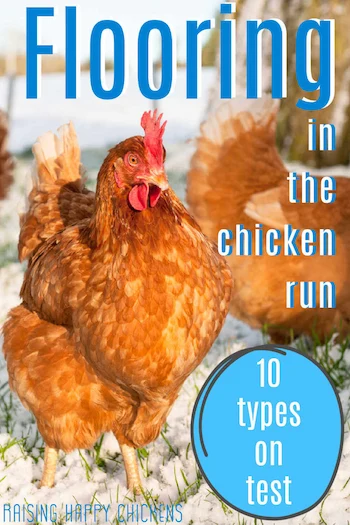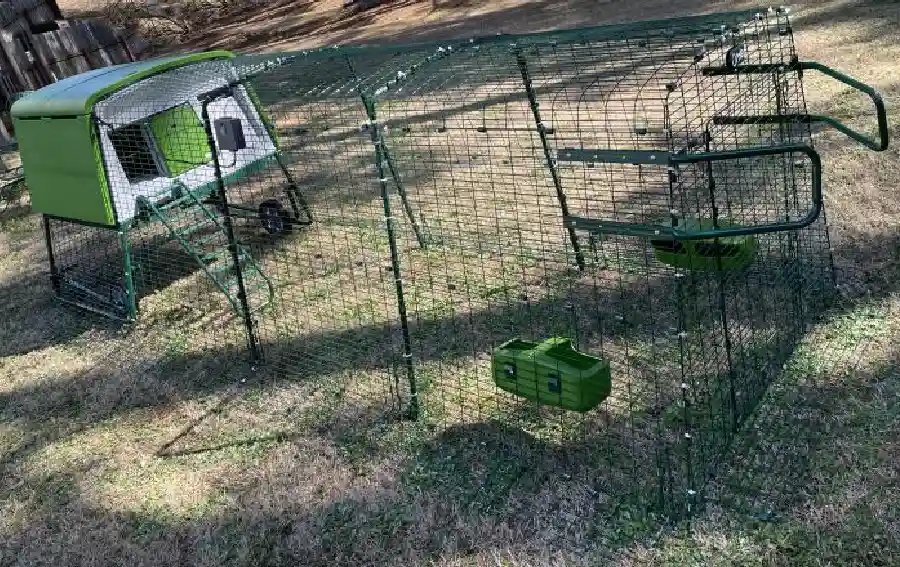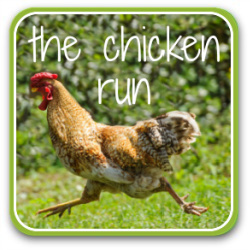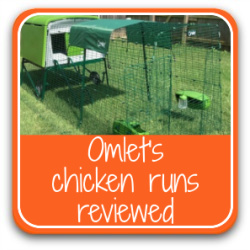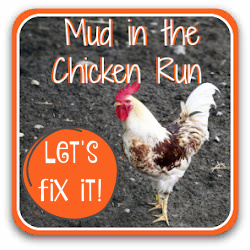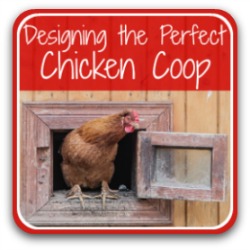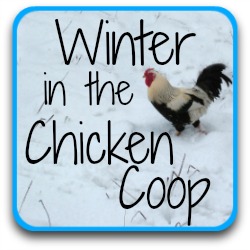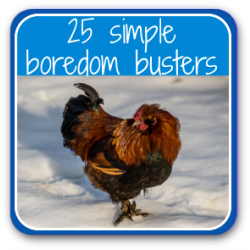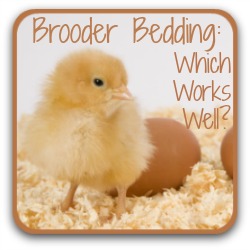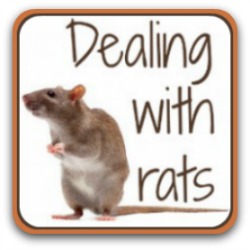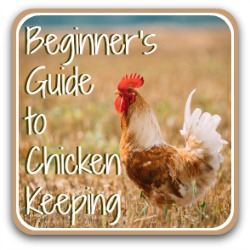- Home
- Chicken runs
- Flooring
Best flooring for a chicken run: 10 options compared.
It's raining, and your lovely grassy chicken run has turned to mud overnight.
If you’ve ever watched a grassy run turn into bare earth – and then mud – almost overnight, you’ll know why this question matters. Even a few chickens can quickly scratch grass to the roots. And once the soil is bare, it only takes one rainstorm to create a mud bath.
Before choosing flooring, it’s worth checking your setup. Is your coop at the bottom of a slope where water collects? Is it exposed to rain or snow from several sides? If so, you're probably dealing with the worst nightmare of any chicken keeper – the muddy run.
Flooring in the run can make a huge difference. The ideal choice is one that keeps the run dry, safe, and easy to clean, while still letting your chickens forage and dust bathe.
Here are my top takeaways, followed by a full look at ten different flooring options together with their pros and cons.
🪶 Featherlight Takeaways.
Quick insights from this article – especially helpful if you're looking for "at-a-glance" recommendations to sort problems in your run. Read on for details.
- Best all-rounder: wood chips (natural, compostable, and good for scratching).
- Best for small runs: hemp (super-absorbent, dries out droppings fast).
- Best for hot weather: sand (drains well and doubles as a dust bath).
- Best budget/eco option: leaves & pine needles (free, compostable, but keep dry).
- Worst option: mesh flooring – unsafe, unhealthy, and not suited for backyard chickens.
Must-have features for chicken run flooring.
The best flooring is whatever keeps your run dry, clean, and safe while making life easier for you in maintaining it.
Here are the essentials:
✅ Dryness & hygiene: flooring should drain well, help dry out droppings, and reduce bacteria build-up.
✅ Durability: choose a surface that holds up over time and suits the size of your run – and your budget.
✅ Easy to clean: the simpler it is to rake, replace, or compost, the better.
✅ Supports natural behaviour: chickens need to forage and dust bathe, so the best flooring is a surface that allows scratching and, ideally, creating a natural dust bath.
✅ Bonus tip: If your run is large, you don’t have to cover it all. Use a movable fence to section off a smaller area with good flooring during the wettest months, or add a roof to one corner.
1: Grass plus chicken tractor.
Good solution for a small flock.
A grassy run is every chicken’s dream in spring and summer. They’ll scratch for bugs, nibble weeds and healthy plants, and make their own dust baths.
The downside? Even a small flock will quickly strip grass to bare soil, which soon turns to mud.
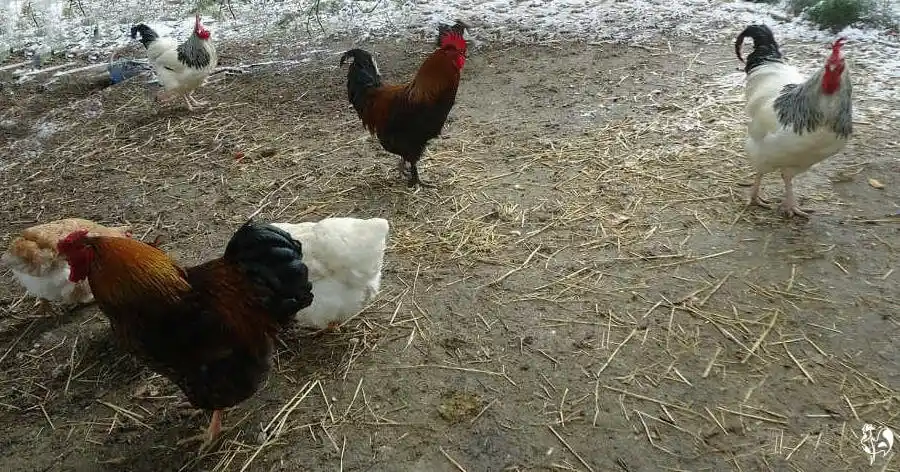 My large, grassy run – turned into a mudbath by a combination of snow and chickens.
My large, grassy run – turned into a mudbath by a combination of snow and chickens.A simple solution is a chicken tractor: a movable enclosure that lets you rotate your chickens onto fresh ground. This gives grass time to recover and can even help you prepare vegetable beds, as the flock weeds and fertilises as they go.
Wooden versions are easily found...
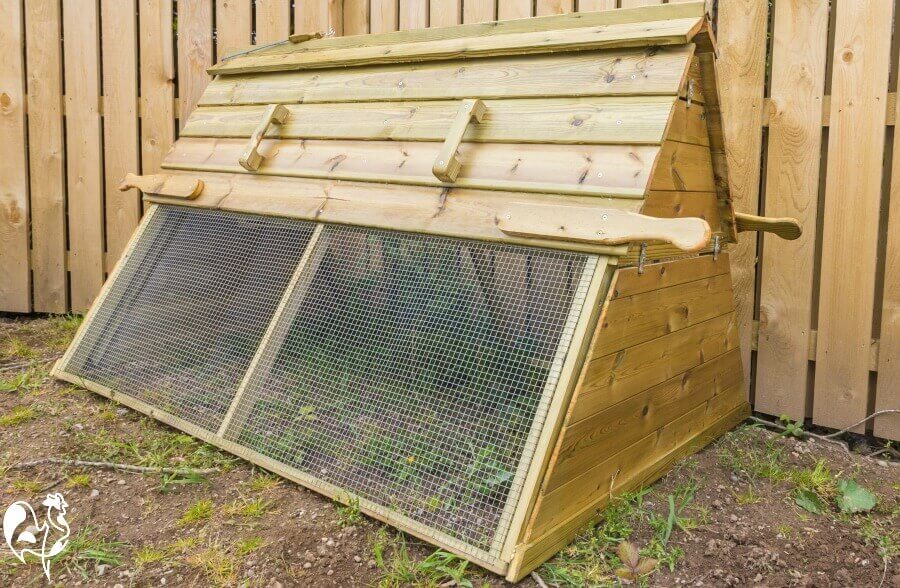 A wooden chicken tractor can be the answer for a grassy run.
A wooden chicken tractor can be the answer for a grassy run.and Omlet's Eglu Cube, which can be bought with wheels on the coop and handles on the run, is easily moved and works well as my own solution.
Pros:
- Allows for (limited) natural foraging and creating dust baths.
- Healthy, green environment for your flock as grass has time to re-grow.
- Can turn chickens into mobile weeders in the vegetable patch, adding valuable poop-fertiliser as they go!
Cons:
- Limited access to worms and bugs compared to free-ranging in a large run.
- Works best for small flocks – larger flocks need bigger tractors.
- Providing the tractor adds to overall cost.
2: Concrete slabs, with topping.
Best solution for a muddy run.
Concrete (especially large paving stones) can be a practical solution for small to medium runs where mud is a constant problem. It creates a solid base that stops rodents digging and makes cleaning easier.
Always cover a concrete base with an absorbent topping such as hemp, wood chips, or sand: bare concrete doesn't allow for chickens to scratch about, which is one of their top welfare needs.
And use individual paving stones rather than one large concrete slab: it allows water to drain between the cracks, reducing the risk of flooding the area.
Pros:
- Solid, rodent-proof base.
- Easy to clean with a rake or hose.
- Works especially well for smaller or partially covered runs.
Cons:
- Needs a topping: bare concrete kills growth beneath it so there's no greenery or bugs for the flock to forage.
- Doesn't work with the deep litter method, which needs an earth base to work well.
- Not eco-friendly if poured as a single slab – rain water will pour off it and can erode the ground around it.
- Expensive and impractical for large runs: try laying slabs on one part of the run so it's manageable.
- Toppings can be kicked off unless held in place, for example by a wooden frame a couple of inches higher than the concrete.
🐥 A note from my flock: before I refurbished my run, I tried using bricks. As you can see from the photo below, the combination of rain and droppings quickly turned it into a soggy mess – proof that concrete only works well with the right topping.
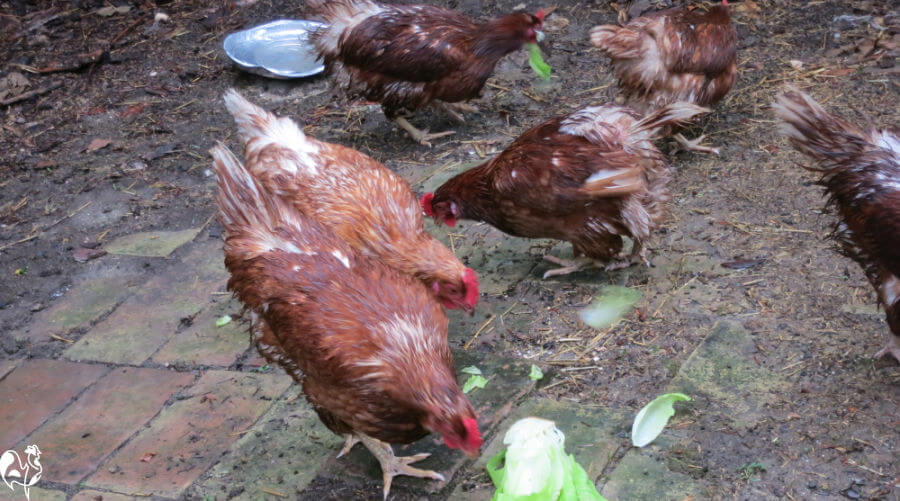 Bricks plus rain = a mess. Add an absorbent top layer.
Bricks plus rain = a mess. Add an absorbent top layer.If you purchase a product through links on this page, I may receive a small commission at no extra cost to you. I only recommend products I have bought (or would buy) myself, and which I believe will genuinely benefit you. You can read my full disclosure policy here.
3: Hemp bedding.
An excellent organic, environmentally friendly choice.
Hemp is one of the most absorbent and eco-friendly flooring options available.
Look for names like Aubiose (horse bedding) or AubiChick (the poultry version) – either will work well in the chicken run.
It composts down beautifully, dries droppings quickly, and goes a long way because it’s sold in compressed bales.
Pros:
- Organic, compostable, eco-friendly.
- Super absorbent, dries out droppings faster than any other bedding.
- Economical: it's sold compressed, so once spread a little goes a long way.
- Adding it to a solid base (see above) with a cover works well in areas with very heavy rainfall.
Cons:
- Expensive compared to other options.
- Doesn’t cope well if it gets soaked outdoors, though it stays drier for longer than other bedding.
- Needs regular turning to prevent mould spores.
4: Wood chips.
Best for large runs and deep litter systems.
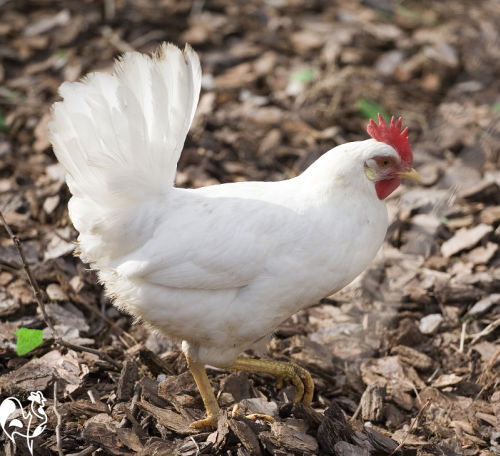 Wood chips can make an inexpensive, natural flooring in the run.
Wood chips can make an inexpensive, natural flooring in the run.Wood chips are a natural, inexpensive option which work well in both the coop and the run.
They compost down slowly, making them eco-friendly, and are excellent as the base of a deep litter system.
My experience has been that chickens prefer other bedding, particularly sand and compost, but will still happily scratch through wood chips.
And research (e.g. 1, 2) shows they’ll still dust bathe and forage even if chips are their only bedding.
So they don't disappear into mud, you’ll need the larger, chunkier chips in a layer at least 5cm (2") deep.
Pros:
- Affordable and widely available.
- Break down for compost over time.
- Suitable for deep litter systems.
- Encourage natural behaviour, particularly scratching.
Cons:
- Quality can vary: beware of cheap brands which often contain a lot of dust, and sometimes, mites.
- Not very absorbent when wet.
- Thin layers quickly disappear into mud.
- Do not use coloured or scented chips, which are chemically treated and unsafe for poultry.
5: Sand.
Best for keeping the coop and run cool in summer.
Coarse builder’s sand (not play sand which is too fine) has become a popular flooring for coops and smaller runs. It drains well, helps control odour, and doubles as a ready-made dust bath.
Sand is low-maintenance in smaller spaces but may be impractical for large runs, as it needs a thick layer to work effectively. The answer is to section off a smaller part of a large run and use sand there.
Pros:
- Excellent drainage, keeps both coops and runs drier and naturally dries out poop.
- Keeps the coop and run cool in hot summer months.
- Natural dust bath, which is one of the most important poultry welfare needs.
- Helps reduce flies, dries out poop and kills bad smells.
- Easy to rake and spot-clean.
Cons:
- Needs a thick layer (15 cm / 6"+), otherwise it will disappear into soil; this can make it an expensive option.
- Doesn’t compost well after use (but works well to improve drainage when added to heavy, clay soils).
- Can get very hot in full sun.
- Heavy to install and maintain in large runs.
🐥 A note from my flock: my chickens love dust-bathing in the sand on hot days, but beware of scorching feet if it's in a sunny spot. I keep shady parts available, using trees and shrubs, which works well.
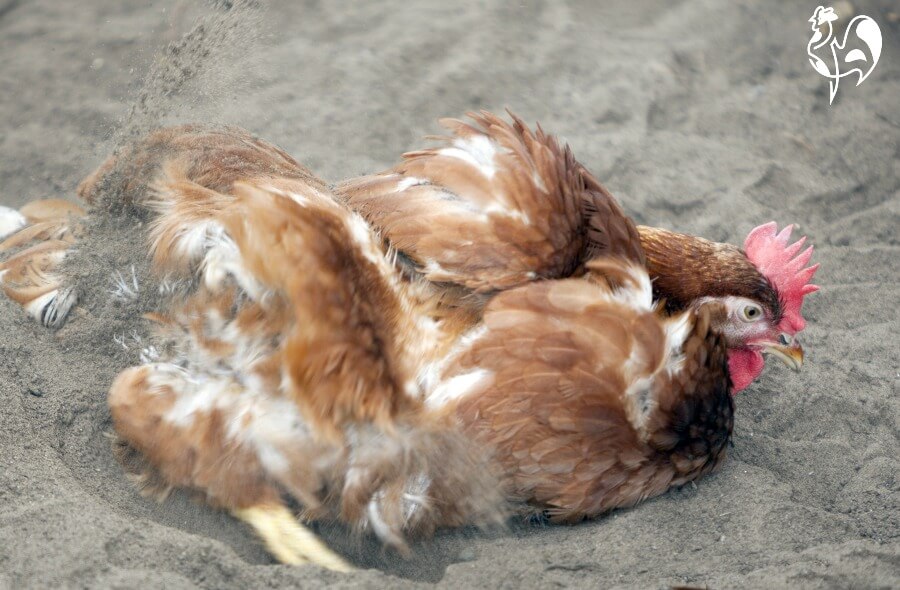 Dry sand makes an excellent dust bath.
Dry sand makes an excellent dust bath.6: Leaves and pine needles.
Best for budget-friendly, eco-friendly bedding.
Leaves and pine needles are a free, natural, eco-friendly option that provide endless entertainment for foraging chickens. They create a deep litter that’s rich in insects and, as a bonus, break down into excellent compost.
If you don’t have your own supply, neighbours are often happy to share, or you can buy compressed “pine straw” bundles online. Make sure it doesn't have colouring or additives.
Always collect and bag the leaves or pine needles on a dry day. I use old feed bags to store the leaves, which makes this method even more environmentally friendly.
Pros:
- Free (or very cheap) and environmentally friendly.
- Great for foraging and enriching, meeting chickens' welfare needs.
- Excellent to use with the deep litter method.
- Compost down well for the garden.
- Easy to collect and replenish.
Cons:
- Must be kept dry: wet leaves can go mouldy and affect chickens' respiratory systems.
- Require regular turning in a deep litter system.
- Not suitable in wet conditions as the only flooring: covering part of the run is an option but may not always be possible.
🐥 A note from my flock: I like raking a pile of autumn leaves into the run as a great boredom buster. The chickens spend hours scratching through them searching for bugs.
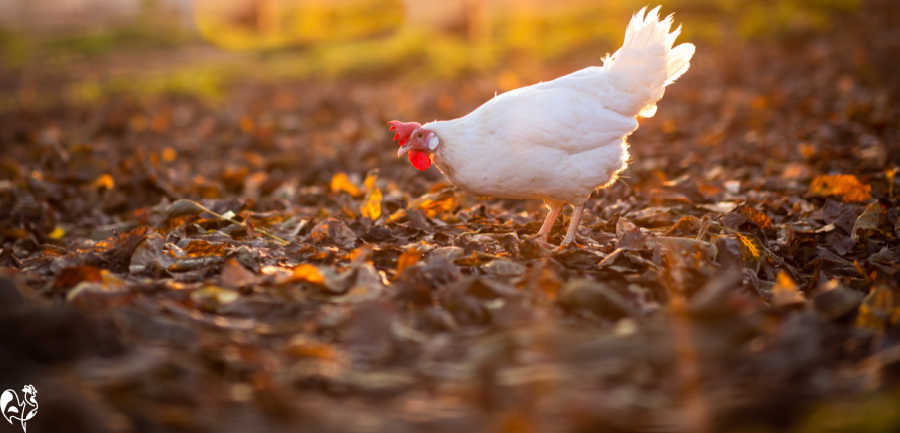 Miss Molly enjoying scratching in a pile of autumn leaves.
Miss Molly enjoying scratching in a pile of autumn leaves.7: Pine shavings, pellets and bark.
Best for small, dry runs or as part of a mix.
Pine products are often used as bedding in coops and brooders, but results in runs can vary. Shavings and pellets are affordable and smell pleasant, while bark is generally unsuitable.
Be careful though: don't mix up pine wood chips with pine shavings. The chips are chunky pieces of wood, while shavings are exactly that: pieces of wood shaved thinly.
- Pine shavings are cheap and compostable, but not very absorbent.
- They can work well in chick brooders as long as they're regularly turned and cleared of poop.
- Pine pellets expand when wet and create a fluffy sawdust layer, though they’re pricier. A good solution for a smaller run.
- Bark tends to harbour mould and mites and is best avoided.
Pros:
- Inexpensive and widely available.
- Pine pellets are highly absorbent.
- Compostable (though slow to break down).
Cons:
- Pine shavings deteriorate quickly outdoors, and even within a coop can leave poop without it drying out. That can lead to issues with excess ammonia.
- Pellets can be costly and need regular turning.
- Bark quickly becomes mouldy and unhealthy.
- This short video compares using pine pellets to hemp – and decides that hemp is the best option.
🐥 A note from my flock: I’ve tried all three. Shavings smelled lovely but turned soggy in no time; pellets worked better but cost more. Bark was a disaster. Never again!
8: Straw.
Best for nest boxes, not good for runs.
Straw is inexpensive and easy to find, but it’s not absorbent and quickly becomes damp and mouldy in outdoor runs. It can also harbour mites.
The only place I recommend using straw is in nest boxes, where it stays dry and is used only for laying.
Pros:
- Cheap and readily available.
- Fine for nest boxes.
Cons:
- Not absorbent. Even without damp weather, poop will lie on top and create wet straw.
- Quickly becomes mouldy in those damp conditions – and smells.
- Can harbour mites and spores which are a danger to the respiratory system.
- Can create an unhealthy run.
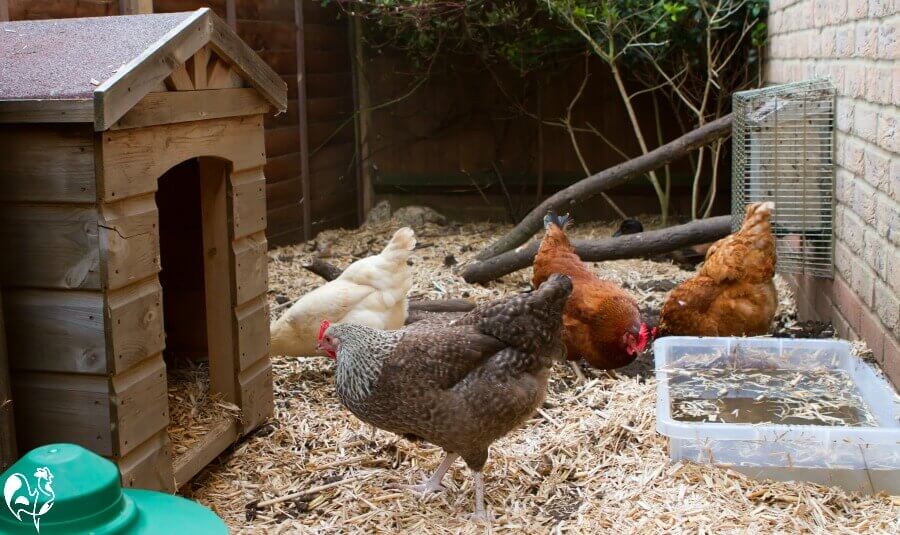 This small backyard run uses chopped straw kept dry by a weatherproofed roof – but note the poop on top.
This small backyard run uses chopped straw kept dry by a weatherproofed roof – but note the poop on top.9: Gravel.
Best as a base layer on heavy clay soil.
Gravel can help improve drainage in hard, clay-based runs that otherwise turn to mud, and can help a run which has already become very muddy. It’s long-lasting and won’t break down like organic beddings.
To be effective it again needs to be at least 5 - 8 cm (2 - 3 inches) deep, and if the surface is on a slope it will need to be contained by an edge of some kind. Otherwise, rains will wash it away.
Don't lay a membrane underneath. The poop will wash through the gravel and collect on the membrane, creating problems with bacteria.
Use pea gravel rather than builders’ gravel. It’s smaller and smoother, so kinder on chicken feet.
Pros:
- Can improve drainage on runs formed from clay soil.
- Long-lasting, doesn’t decompose or turn to mush.
- Low-maintenance once installed.
Cons:
- Hard on feet, can cause lesions which then allow infection and create issues like bumblefoot.
- Difficult to clean poop from the surface. Using it as a base layer and covering with some top soil can work, though you'll need to keep adding soil as it will tend to drain away.
- No foraging or dust bathing opportunities, both of which are critical to a chicken's welfare needs.
- Needs edging to stop it washing away on slopes.
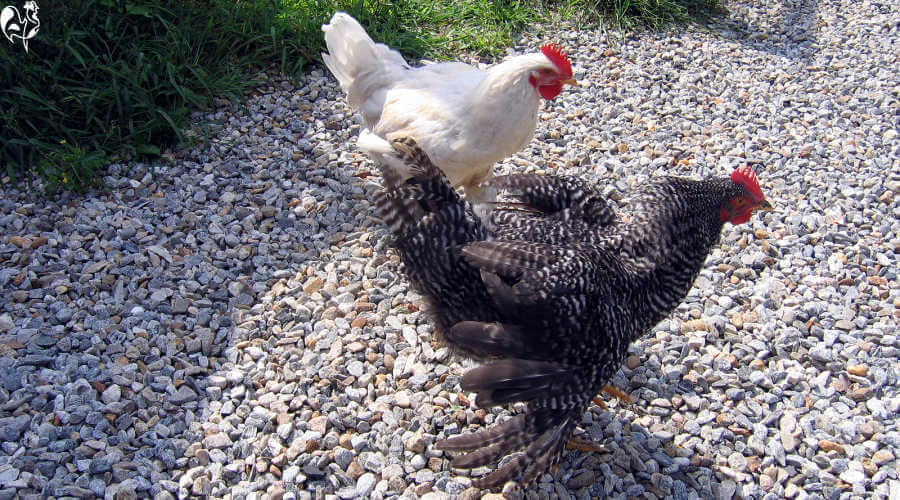 Gravel: free draining but doesn't allow for welfare needs.
Gravel: free draining but doesn't allow for welfare needs.10: Metal.
Not recommended for backyard chickens.
Mesh floors are sometimes used in commercial systems, with droppings falling through into a pit below. It's used commercially because it's cheap, and easy to clean.
But for backyard chickens, mesh is unsafe and unsuitable.
It prevents natural behaviours like scratching and dust bathing, and can even injure chickens’ feet and legs.
Pros:
- Easy to hose or brush clean.
- Stops rodents digging in.
Cons:
- Dangerous for feet: there's a high risk of cuts, breaks, and bumblefoot.
- No chance to forage or dust bath, so welfare needs are unmet.
- Because there's no ground to scratch on, can lead to overgrown nails and beaks.
🐥 A note from my flock: I’ve seen commercial mesh floors up close, and I wouldn’t wish them on any backyard flock. Chickens need soil, not metal, beneath their feet.
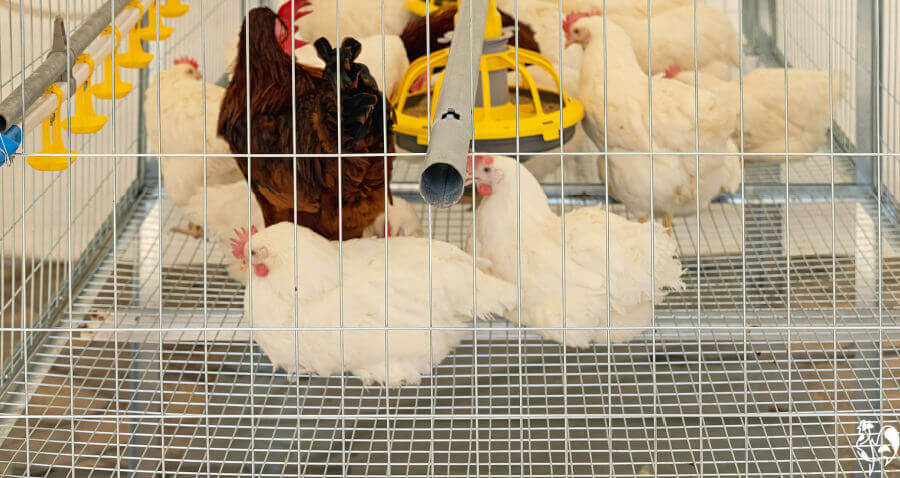 Mesh has no place in a backyard chicken keeper's coop or run.
Mesh has no place in a backyard chicken keeper's coop or run.Summary: which is the best flooring for your chicken run?
There’s no single best flooring that fits every flock. The right choice depends on your individual climate, run size, and budget.
The key is to keep the run dry, clean, and safe, while giving your chickens the chance to scratch and dust bathe.
- For a small, covered run, hemp is hard to beat for absorbency.
- For larger runs, chunky wood chips or leaves and pine needles make a natural, compostable solution.
- Sand works well in hot, dry climates, while gravel can help drainage on heavy clay soils.
- The only surface to avoid completely is mesh, which isn’t safe or welfare-friendly.
If one option doesn’t work for your setup, don’t be discouraged. Try another until you find the right balance for you and your flock.
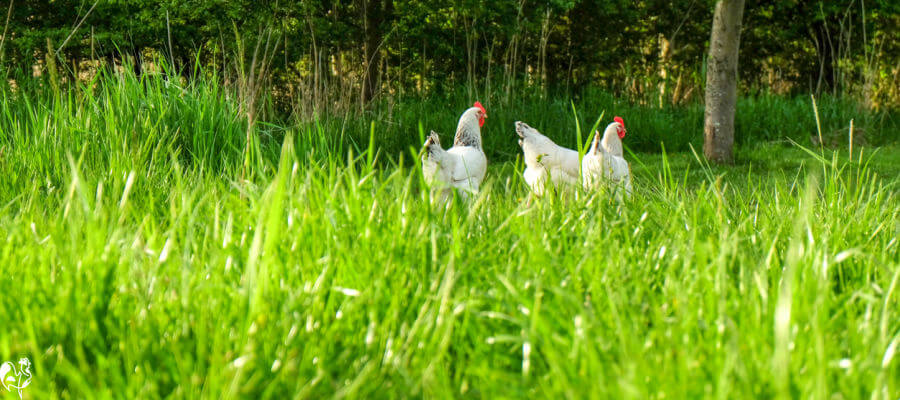 Test out the different flooring options until you find the perfect solution.
Test out the different flooring options until you find the perfect solution.Frequently Asked Questions: chicken run flooring.
What type of sand is safe for runs?
What type of sand is safe for runs?
Use coarse, builder’s sand, not fine or "play" sand. The larger grains help with drainage and are gentler on chickens' feet.
How deep should flooring materials like wood chips be?
How deep should flooring materials like wood chips be?
A good starting point is about 5 cm (2"). Any less and they will sink into mud; too deep, and the costs and maintenance skyrocket.
Is concrete a suitable flooring for chicken runs, and what are the catches?
Is concrete a suitable flooring for chicken runs, and what are the catches?
Yes, for smaller runs or problem-prone patches concrete can be useful. For ecological reasons use paving stones rather than one large block of concrete, and cover with an absorbent topping to allow for scratching and dust-bathing.
What if I can’t convert the whole run?
What if I can’t convert the whole run?
You don’t have to. Focus on the worst areas: section off a corner, lay a better base, cover with a weather-proof tarpaulin. Small improvements to a smaller part of a large run can make a big difference.
What is the best thing to put on the bottom of a chicken run?
What is the best thing to put on the bottom of a chicken run?
This depends entirely on your individual situation, including size of run, your local climate, budget and available time to upkeep it. This article will help you work out which is best for you.
More articles about the chicken coop and run.
Sources and further reading.
A lot of "facts" you'll find on the internet are often people's individual views, based on inaccurate information repeated from poor quality sources.
The information I provide in this article and others is based not just on my own experience, but on evidenced facts from scientific, peer-reviewed research and books from highly respected and experienced poultry keepers such as Gail Damerow.
Some of the trusted sources I have used in this article are these.
1. Monckton, V, et al: Floor Substrate Preferences of Chickens - a Meta-Analysis. Pub. Journal of Veterinary Science, 2020.
2. Shields, Sara, et al: Effect of sand and wood shavings on the behavior of broiler chickens. Pub. Journal of Poultry Science, 2006.
- Home
- Chicken runs
- Flooring
